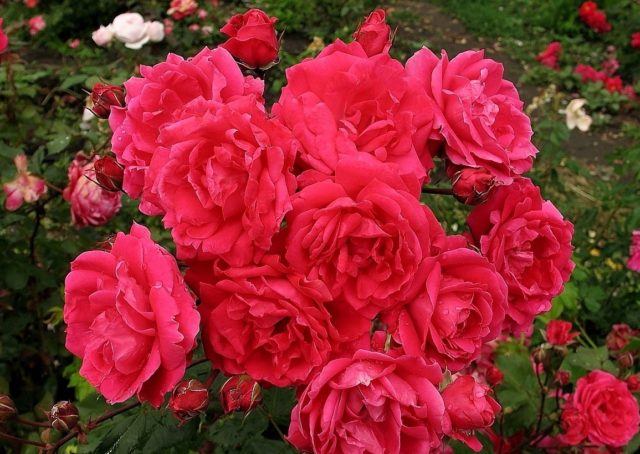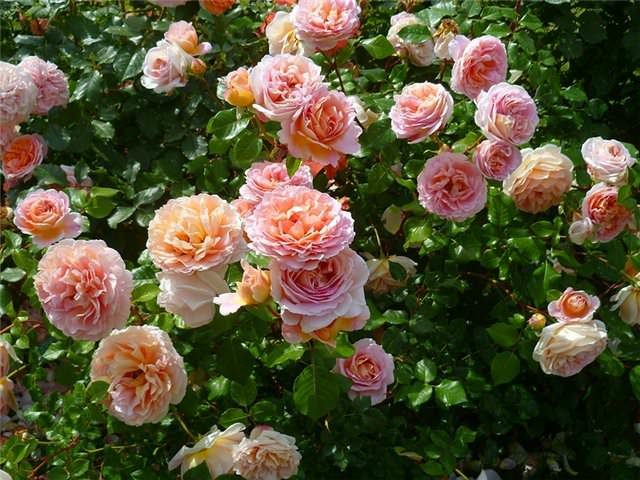Content
Roses are considered a demanding and whimsical plant. Because of this, not every gardener decides to grow such a flower on their site. Planting and caring for a park rose is a much less difficult option for beginners. This plant is not so whimsical, adapts well to any conditions and is suitable for different regions of the Russian Federation.
Features of growing park roses
For the full growth of ornamental plants, certain conditions are necessary. Park roses are less demanding than bush roses. This category includes varieties specially bred by breeders for such plantings. Park roses have increased adaptive abilities, thanks to which they can quickly adapt to environmental conditions.
Main features of cultivation:
- Park roses are a medium-sized shrub with strong stems.The plant is less sensitive to mechanical stress and winds.
- Park varieties are resistant to low temperatures. In many regions they spend the winter without shelter, as they easily tolerate frosts.
- High resistance to disease makes park roses insensitive to infections. Bush varieties are much more likely to be attacked by insect pests
- Park roses bloom longer and more abundantly. They attract pollinating insects.

Some varieties bloom twice per season
Typically, the buds of park roses bloom in late May or early June. This is 2-3 weeks earlier than most bush species. They do not need frequent watering, pruning, or fertilizing.
Types of park roses
Gardeners distinguish two main groups - with single and repeated flowering. When decorating landscape designs, Canadian and English park roses are usually used.
These species differ in the structure of the bushes. Most Canadian roses have erect stems, while English roses have twining stems.
The most popular varieties:
- William Shakespeare;
- Quarda;
- Abraham Derby;
- Prairie Joy;
- Parsla;
- Alexander MacKenzie;
- Westerland.
Thanks to the variety of varieties, every gardener has the opportunity to choose a rose of the desired size and flower color. This is especially important for those who use plants to create decorative compositions on their site.
Conditions for planting park roses
The main advantage of such plants is their unpretentiousness. Planting and caring for a park rose in the garden comes down to a minimum set of activities.
Bushes are planted singly or in groups. You need to decide on a site for the plant in advance.Before planting, it is advisable to familiarize yourself with the varietal characteristics, find out the degree of frost resistance and the basic requirements for the composition of the soil.
When to plant park roses
Such plants are classified as frost-resistant. They are best planted in open ground in the fall. Then the park rose will have time to adapt to the new place and take root before the onset of cold weather. If you plant a plant in the spring, it will spend energy on the growth of surface shoots. The roots will remain weak.
Another reason why it is recommended to plant park roses in open ground in the fall is that the plant is not subject to summer drought. It is best to plant the bush in early September, before the onset of cold weather and heavy rainfall.
How to plant a park rose
The technology of planting in open ground is not much different from other ornamental crops. It is necessary to prepare the site and soil for the park rose and select a good seedling. These steps are performed in accordance with the instructions.
Requirements for place and soil
Park roses adapt well to open ground conditions, but they cannot be planted absolutely everywhere. In order for the plant to develop normally and bloom regularly, several requirements must be met.
The place for the park rose should be well lit by the sun. Light promotes the formation of buds and abundant flowering. It is advisable that the roots of the bush are protected from sunlight and eliminate the risk of overheating.

In one place, park roses can grow for up to 50 years.
Bushes require good aeration. It is advisable to plant in places where air circulates freely, but there is no strong draft.
When choosing a location, you should make sure that there are no potential sources of infection nearby. These include fruit trees, shrubs and other ornamental plants.
The soil for park roses must meet the following requirements:
- looseness, lightness;
- good breathability;
- neutral acidity;
- sufficient nutrient content.
If the site has poor, infertile soil, you need to prepare the planting site in advance. The soil is being dug up. Compost or humus is added to it to attract earthworms. They secrete vermicompost, which is the best source of nutrients for plants.
Preparing the rose
Seedlings are used as planting material. They are best purchased from nurseries or garden stores. It is advisable to take planting material in small pots. It is enough to transfer them into the hole along with a lump of earth, dig in with fresh soil and water.
Bare-rooted seedlings must be prepared:
- Place in cold water for 2-3 hours.
- Inspect the root for damage, defects, and areas of rot.
- Trim broken roots.
- Immerse the lower shoots in a fungicidal solution for 20 minutes immediately before planting.
Until planting, seedlings should be stored in a cool place. A basement or cellar is best. Sprouts with bare roots must be planted within 3-5 days, otherwise they will dry out.
Planting a park rose
The procedure is carried out in the evening. In this case, the weather should be favorable, without heavy rainfall.
How to land:
- Dig a hole 70 cm deep.
- Expanded clay or crushed stone is placed at the bottom to drain liquid.
- Pour a layer of loose soil mixture.
- A seedling is placed inside.
- Cover with soil and lightly compact around the shoots.
- Water it with water.

The root collar of the plant is deepened by 5-6 cm
After planting in the fall, the plant needs to be watered 1-2 times a week until precipitation appears. Then the frequency is reduced so that the bush prepares for winter on its own.
How to care for park roses
After planting in open ground, the plant is exposed to various unfavorable factors. In order for it to adapt to new conditions and continue to please with regular flowering, several agrotechnical measures are required.
Watering, mulching and loosening
The listed procedures are required for any type of roses. Park varieties are less sensitive to lack of liquid and drought. Rare but abundant watering is recommended. Each adult bush requires 20-30 liters of warm, settled water.
Watering is carried out once a week. If there is precipitation, the frequency is reduced. The leaves of park varieties quickly evaporate moisture. In dry weather, sprinkling is recommended.
The most water is added in the fall, in preparation for winter. For 1 bush, use 50-60 liters of liquid so that the roots are fully saturated.
To retain moisture in the soil, mulching is recommended. Use tree bark, sawdust, straw. Mulch is placed on the soil after watering in a layer of 5-10 cm.
Loosening of the soil is carried out as compaction progresses. With infrequent watering, the soil remains light for a long time. Therefore, the procedure is required once every 1-2 months.
Feeding
Proper care of the Canadian park rose is not complete without fertilizers. In the first year after planting in the ground, fertilizing is not needed. In April, the bushes are fertilized with a complex mineral composition.Bird droppings or rotted manure are also used - 100 g for each bush.
The second time ammonium nitrate is used is in May. For 1 sq. m of soil add 10-15 g of solution. Repeated mineral replenishment is carried out in early June.
When the buds fade, it is recommended to add compost and superphosphate. In August, final fertilizing is done with potassium salt and wood ash.
Pruning and shaping the bush
For the first 2-3 years, park roses do not need pruning. Subsequently, the bush is pruned while removing weak and dry shoots. It is given a bowl-shaped shape.

The cut areas should be treated with disinfectant solutions.
Only those varieties that bloom twice a year are sheared. Bushes that bloom once do not need to be pruned.
Diseases and pests
Park roses are resistant to infections. Diseases develop only with gross violation of growing technology or with a complete lack of care.
Possible diseases:
- powdery mildew;
- fusarium wilt;
- black spot;
- gray rot;
- rust.
The method of treatment depends on the type of infection. Typically, broad-spectrum fungicides are used. Affected shoots must be removed from the bushes to prevent the infection from spreading. Spray with fungicide 2-3 times.
Roses can be affected by pests:
- aphid;
- pennies;
- spider mites;
- leaf rollers;
- Scale insects.
To repel pests, it is recommended to spray park rose bushes with a soap solution, infusion of garlic or calendula. When plants are damaged, complex treatment with insecticides is required.
How to propagate park rose
There are several methods for obtaining a new plant when a mother bush is present.One of the advantages of park roses is that they reproduce well by almost any means.
Cuttings
The method is considered the simplest, but time-consuming. Half-woody stems are used as planting material. They are separated before or after flowering.

The optimal cutting length is 12-15 cm
The cut stem should have 2-3 leaves and the same number of buds. The lower part of the cutting is immersed in water until small roots appear. Then it is planted in a nutrient substrate.
Dividing the bush
The procedure is carried out in April or early May. The bush is dug out of the soil and divided with a sharp knife or pruning shears. The upper shoots are pruned. Each division is soaked in an antiseptic solution, then planted in open ground or containers with nutritious soil.
Reproduction by layering
Park roses have fairly flexible stems for this procedure. Choose a healthy young shoot, which is bent down and pressed to the ground. The top is covered with soil and watered.
Layering is done in the spring season. They take root before autumn. Next spring they are separated from the mother bush and planted in a new place.
Reproduction by offspring
A large number of side root shoots are formed on park roses. They usually grow on the south side of the bush. They are separated from the plant and planted in a container with well-fertilized soil. As a result, a young seedling is obtained from the root offspring, which can be planted in an open place in the fall.
Reproduction by grafting
Varietal roses are grafted onto rose hips.The method involves transferring one part of the plant to another. For propagation, a cutting or bud of a rose is grafted onto a rose hip bush.
The procedure is carried out in spring. The advantage of the method is that it allows you to preserve the varietal characteristics of the flower. The main disadvantage is that growing new planting material takes a lot of time. In addition, grafted cuttings and buds often do not take root on the new bush.
Recommendations
To make growing and caring for park roses easier, you should use a few tips from experienced gardeners. This will help eliminate common mistakes among beginners.
Useful tips:
- The planting hole should be 2-3 times deeper than the height of the seedling.
- Only rotted litter or manure is used as fertilizer. Fresh can cause root rot.
- When planting, the roots of a seedling can be dipped in a clay solution to protect it from nematodes and speed up growth.
- Lime is added to soils with high acidity.
- Park roses should not be planted too close so that they do not shade each other.
- To protect against pests, tobacco ash is added to the soil next to the bush.
- Flowers should be removed from the plant immediately after wilting.
When growing park roses, it is important to follow basic agrotechnical standards. Improper care can lead to premature wilting and death of the plant.
Conclusion
Planting and caring for a park rose is a step-by-step process that requires a competent and responsible approach. Despite their unpretentiousness, such plants need to be provided with suitable conditions. Then they will be able to please the owner with regular and lush flowering, absence of diseases and resistance to adverse factors.















